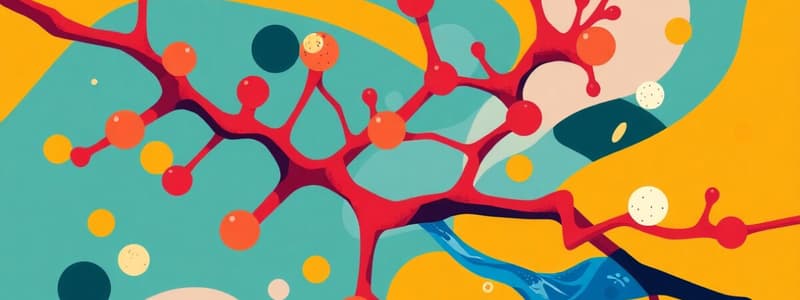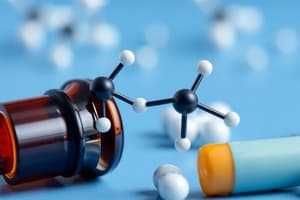Podcast
Questions and Answers
What bodily function is primarily regulated by the parasympathetic nervous system?
What bodily function is primarily regulated by the parasympathetic nervous system?
- Increased heart rate during exercise
- Digestion after a meal (correct)
- Bronchodilation during exercise
- Vasodilation during stress
Which of the following is the primary neurotransmitter associated with the parasympathetic nervous system?
Which of the following is the primary neurotransmitter associated with the parasympathetic nervous system?
- Norepinephrine
- Epinephrine
- Acetylcholine (correct)
- Dopamine
Which receptor type primarily mediates the effects of acetylcholine (ACh) in cardiac tissue, leading to a decrease in heart rate?
Which receptor type primarily mediates the effects of acetylcholine (ACh) in cardiac tissue, leading to a decrease in heart rate?
- Beta-2 adrenergic receptors in ventricular muscle
- Nicotinic receptors in the sinoatrial node
- Muscarinic (M2) receptors in the sinoatrial node (correct)
- Alpha-1 adrenergic receptors in atrial muscle
Which muscarinic receptor subtype is predominantly involved in increasing gastric acid secretion in the stomach?
Which muscarinic receptor subtype is predominantly involved in increasing gastric acid secretion in the stomach?
Which of the following effects is mediated by M3 muscarinic receptors in the respiratory system?
Which of the following effects is mediated by M3 muscarinic receptors in the respiratory system?
What is the primary effect of stimulating M3 muscarinic receptors on the bladder wall and urinary sphincter?
What is the primary effect of stimulating M3 muscarinic receptors on the bladder wall and urinary sphincter?
What is the effect of stimulating nicotinic receptors at autonomic ganglia?
What is the effect of stimulating nicotinic receptors at autonomic ganglia?
What effect does stimulation of nicotinic receptors at the neuromuscular junction have on skeletal muscles?
What effect does stimulation of nicotinic receptors at the neuromuscular junction have on skeletal muscles?
How do indirect-acting parasympathomimetics, like neostigmine, increase acetylcholine levels in the synapse?
How do indirect-acting parasympathomimetics, like neostigmine, increase acetylcholine levels in the synapse?
Which of the following characteristics distinguishes carbachol from acetylcholine?
Which of the following characteristics distinguishes carbachol from acetylcholine?
Which clinical condition is bethanechol commonly used to treat?
Which clinical condition is bethanechol commonly used to treat?
Pilocarpine is used topically in the eye to treat glaucoma. By what direct mechanism does pilocarpine reduce intraocular pressure?
Pilocarpine is used topically in the eye to treat glaucoma. By what direct mechanism does pilocarpine reduce intraocular pressure?
Cevimeline is prescribed to treat xerostomia (dry mouth). What receptor type is primarily responsible for mediating this therapeutic effect?
Cevimeline is prescribed to treat xerostomia (dry mouth). What receptor type is primarily responsible for mediating this therapeutic effect?
Why is acetylcholine ineffective when administered orally?
Why is acetylcholine ineffective when administered orally?
Activating muscarinic receptors in the eye leads to miosis by what mechanism?
Activating muscarinic receptors in the eye leads to miosis by what mechanism?
A patient with asthma is generally contraindicated for muscarinic agonists. What specific effect of muscarinic agonists leads to this contraindication?
A patient with asthma is generally contraindicated for muscarinic agonists. What specific effect of muscarinic agonists leads to this contraindication?
Which cardiovascular effect is associated with muscarinic M2 receptor activation?
Which cardiovascular effect is associated with muscarinic M2 receptor activation?
A patient is experiencing difficulty with increased saliva production. Which class of drugs would MOST likely be prescribed to reduce this symptom?
A patient is experiencing difficulty with increased saliva production. Which class of drugs would MOST likely be prescribed to reduce this symptom?
What is the primary mechanism by which organophosphate compounds exert their toxic effects?
What is the primary mechanism by which organophosphate compounds exert their toxic effects?
What is the mechanism by which M1 muscarinic receptors affect CNS function?
What is the mechanism by which M1 muscarinic receptors affect CNS function?
Flashcards
Autonomic Nervous System
Autonomic Nervous System
Controls involuntary body activities like heart rate, digestion, and sweating.
Sympathetic Nervous System
Sympathetic Nervous System
A division of the autonomic nervous system which prepares the body for stress; fight or flight.
Parasympathetic Nervous System
Parasympathetic Nervous System
A division of the autonomic nervous system that promotes rest and digestion.
Preganglionic Neuron
Preganglionic Neuron
Signup and view all the flashcards
Postganglionic Neuron
Postganglionic Neuron
Signup and view all the flashcards
Acetylcholine (ACh)
Acetylcholine (ACh)
Signup and view all the flashcards
Cholinesterase (AChE)
Cholinesterase (AChE)
Signup and view all the flashcards
Cholinergic Receptors
Cholinergic Receptors
Signup and view all the flashcards
Muscarinic Receptors
Muscarinic Receptors
Signup and view all the flashcards
Nicotinic Receptors
Nicotinic Receptors
Signup and view all the flashcards
M1 Receptor
M1 Receptor
Signup and view all the flashcards
M2 Receptor
M2 Receptor
Signup and view all the flashcards
M3 Receptor
M3 Receptor
Signup and view all the flashcards
M3 receptor location
M3 receptor location
Signup and view all the flashcards
Nicotinic receptors action
Nicotinic receptors action
Signup and view all the flashcards
Parasympathomimetics
Parasympathomimetics
Signup and view all the flashcards
Direct Cholinergic Agonists
Direct Cholinergic Agonists
Signup and view all the flashcards
Indirect Cholinergic Agonists
Indirect Cholinergic Agonists
Signup and view all the flashcards
Carbachol
Carbachol
Signup and view all the flashcards
Bethanechol
Bethanechol
Signup and view all the flashcards
Study Notes
- These notes cover cholinergic drugs, focusing on parasympathomimetics
Autonomic Nervous System
- The autonomic nervous system (ANS) controls involuntary body activities
- The sympathetic nervous system is activated by stress
- The parasympathetic nervous system promotes peace, rest, and digestion
Parasympathetic System
- Involves preganglionic and postganglionic neurons
- Parasympathetic stimulation leads to miosis, salivation, bronchoconstriction, bradycardia, digestion, and urination
Cholinergic System
- Acetylcholine (ACh) serves as the primary neurotransmitter
- Cholinesterase enzyme (AChE) metabolizes the system
- Receptors include muscarinic (M) and nicotinic (N) receptors
Muscarinic Receptors
M1 Receptors:
- They are found in the central nervous system (CNS) and stomach
- In the CNS, they regulate motor activity, attention, and memory
- In the stomach, they stimulate HCL secretion
- They are Gq protein-coupled receptors, which increase IP3 and DAG, leading to increased Ca2+
M2 Receptors:
- They are located in the heart
- They decrease heart rate via the sinoatrial node (SAN) and the atrioventricular node (AVN)
- They are Gi protein-coupled receptors, which decrease cAMP
M3 Receptors:
- They are located in the eye, lungs, blood vessels, glands and urinary tract
- Cause of miosis, bronchoconstriction, vasodilation, gland secretion and urination
- They are Gq protein-coupled receptors that increase IP3 and DAG, increasing Ca2+
Nicotinic Receptors:
- Functions as ion channel receptors that cause depolarization via increased Na+ influx
- Nn receptors are found in the adrenal medulla which release catecholamines and autonomic ganglia
- Nm receptors are located at the neuromuscular junction, causing skeletal muscle contractions
Parasympathomimetics Classification
- Direct-acting agents include choline esters (Acetylcholine, Bethanechol, Carbachol, Methacholine)
- Direct-acting agents include alkaloids (Pilocarpine, Cevimeline)
- Indirect-acting agents (ChE inhibitors), which are reversible (Physostigmine, Neostigmine, Pyridostigmine, Donepezil)
- Indirect-acting agents (ChE inhibitors), which are irreversible (Organophosphate compounds)
Acetylcholine
- Directly stimulates muscarinic and nicotinic receptors
- Poorly absorbed orally, administered via injection
- Has a short duration of action, rapidly hydrolyzed by cholinesterase
Muscarinic Effects
- Cardiovascular system (CVS): Decreased heart rate (M2), vasodilation (M3), decreased blood pressure
- Respiratory system: Bronchoconstriction (M3), increased bronchial secretion
- Eye: Miosis which stimulates the constrictor pupillae (M3), accommodation for near objects which stimulates ciliary muscles (M3)
- Gastrointestinal tract (GIT): Increased motility, relaxation of sphincters (M3)
- Urinary tract: Stimulates detrusor muscle, relaxes internal urethral sphincter (M3)
- Exocrine glands: Increase in salivary, gastric, bronchial, lachrymal, and sweat gland secretions (M3)
- Nicotinic effects: Stimulation of autonomic ganglia (Nn), increased motor end plate activity leading to skeletal muscle contractions (Nm)
Carbachol vs. Bethanechol
Carbachol:
- Choline ester resistant to hydrolysis by AChE
- Effective orally with long duration
- Stimulates both muscarinic and nicotinic receptors
- Used for open-angle glaucoma via local eye drop decreasing IOP, increasing aqueous humor drainage and causing miosis
Bethanechol:
- Stimulates only muscarinic receptors
- Used post-operatively for urine retention
- Used for paralytic ileus in absence of organic obstruction
Pilocarpine vs. Cevimeline
Pilocarpine:
- A natural plant alkaloid
- Exhibits muscarinic effects
- No nicotinic effects
- Local eye drops decrease IOP in chronic open-angle glaucoma
Cevimeline:
- A synthetic alkaloid
- Exclusively muscarinic effects
- No nicotinic effects
- Administered orally to treat xerostomia, increasing salivary secretion
Muscarinic Agonists
- Hypotension
- Diarrhea, nausea, and vomiting.
- Bradycardia
- Bronchoconstriction
- Sweating and salivation
Muscarinic Agonists Contraindications
- Bronchial asthma
- Heart block
- Peptic ulcers
Review Questions
- The activation of muscarinic receptors in bronchiolar smooth muscle is associated with an increase in IP3 and DAG
- Reduced heart rate (bradycardia) is a systemic effect of a muscarinic agonist
Studying That Suits You
Use AI to generate personalized quizzes and flashcards to suit your learning preferences.




